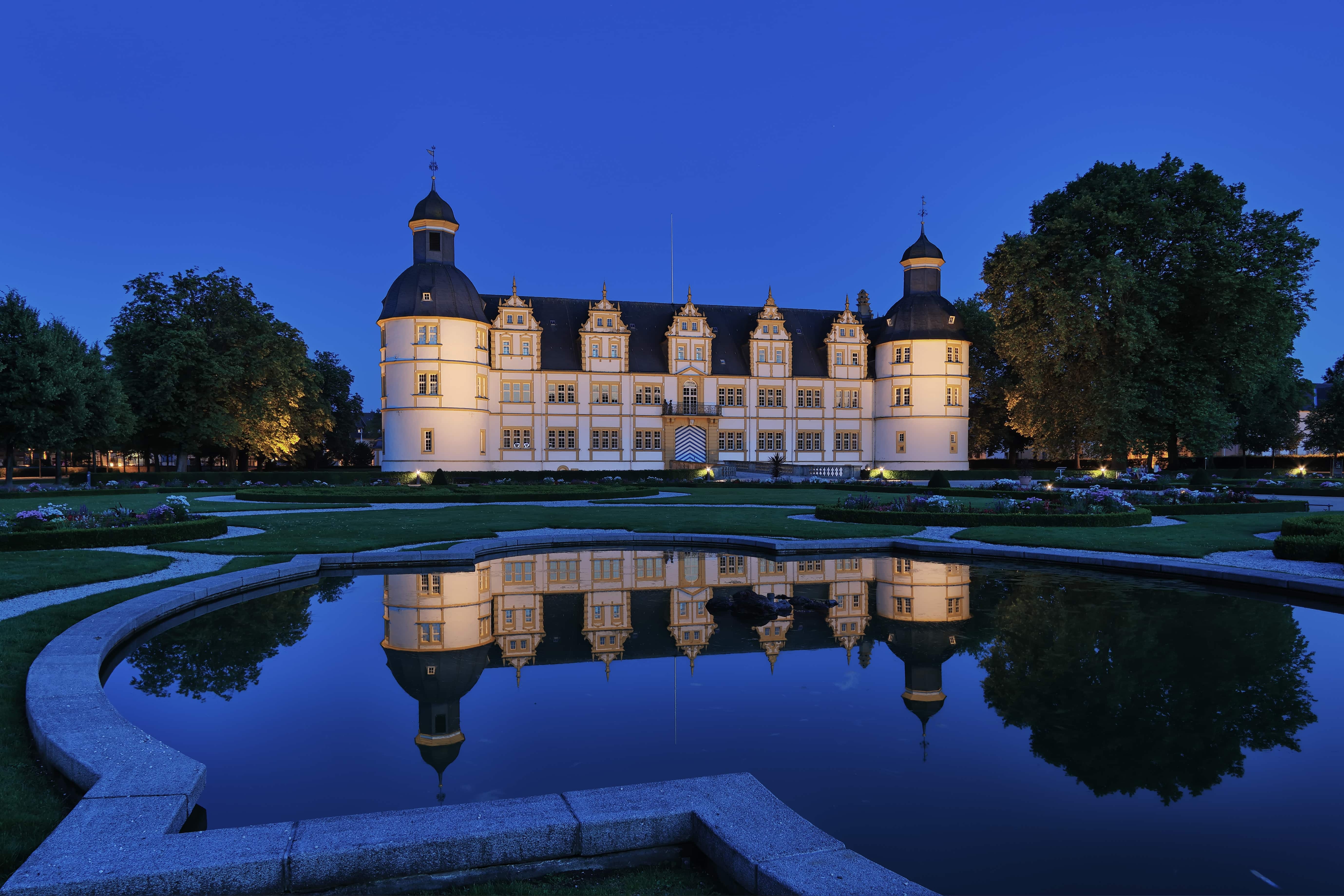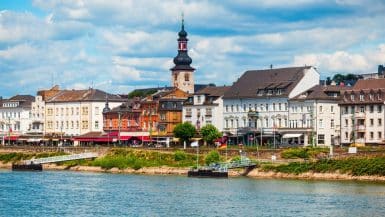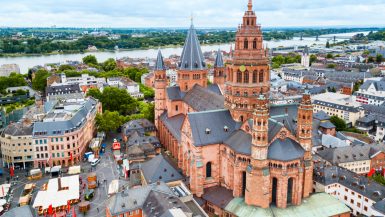As a destination for a city trip, Paderborn is considered an insider tip – for now! Because the East Westphalian metropolis is bursting with culture, art and superlatives: Weser Renaissance, graffiti stronghold, the world’s largest computer museum and Germany’s largest street art fair. Today we introduce you to what there is to see in Paderborn and at what time of year a trip to the city of just over 150,000 inhabitants is particularly worthwhile.
Graffiti art on monastery walls
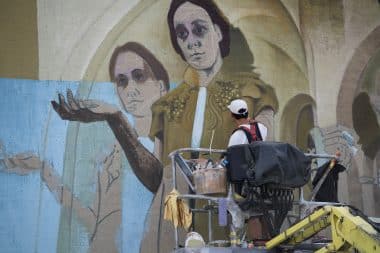
Katharina Mock was tired of the unsightly gray wall of her convent. The Superior General of the Sisters of Mercy of St. Vincenz von Paul zu Paderborn therefore invited graffiti artists from the region in 2018 to paint the approximately 70-metre-long monastery wall. Since then, artists have regularly been allowed to give free rein to their creativity on the wall.
The monastery wall is a symbol of the triumphal march of graffiti in Paderborn’s cityscape. In many places in the city, visitors see colorful murals – huge pictures on the facades of hospitals and companies, the university and private homes. The murals show motifs from pop culture such as Batman or Sheldon from Big Bang Theory as well as local motifs such as Paderborn Cathedral or the Three Hares Window (more on both in a moment).
To make sure you don’t miss any of the colorful works of art, we recommend that you take part in one of the weekly guided tours with a graffiti expert. If none takes place while you are on site, you can use the free multimedia graffiti tour via app, which will take you to the most beautiful murals. The special thing about the East Westphalian city is that the graffiti is particularly present in the city centre and forms an exciting contrast to the many sacred buildings.
Paderborn Cathedral and one of the largest folk festivals in Germany
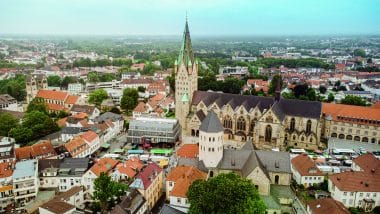
The most striking church building and roof of the city is the Romanesque-Gothic cathedral with its 93-metre-high tower. Anyone who climbs it as part of a guided tour will not only see the fourth-largest bell in Germany, which weighs over 13 tons, but also the completely mechanical movement of the tower clock.
In the cloister of the cathedral, visitors will find the aforementioned Three Rabbit Window. The motif, which originally comes from China , was carved in the 16th century and developed into one of Paderborn’s landmarks, which is taken up again and again in the city’s art and culture.
The cathedral acquired its present form as early as the 13th century. In his crypt the bones of St. John are preserved. Liborius – namesake of the large Paderborn folk festival Libori, which attracts more than 1.5 million visitors to the city every year in July. This makes the week-long festival, which is considered particularly safe, one of the ten largest folk festivals in Germany.
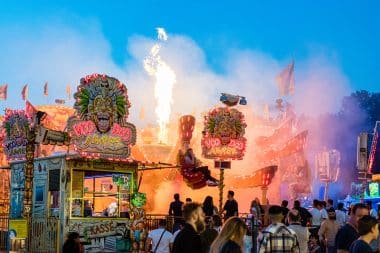
During Libori, the entire city center of Paderborn is transformed into a huge festival where there is a lot to discover. Visitors can expect a colourful hustle and bustle, which is made up of a funfair, church ceremonies and a multifaceted cultural programme: concerts, theatre and comedy will take place on all squares. The funfair mile measures 1.6 kilometers and includes about 150 exhibitors and rides on the Liboriberg. At the traditional Pottmarkt – in the past only pots and pans were sold here – visitors stroll through 140 colourful stalls from brush stalls to herb stalls.
Incidentally, the festival has its Catholic origins in the ceremonial transfer of the relics of St. Liborius from Le Mans in France to Paderborn in 836, which were received with great jubilation in the city. After the ceremonial move-in, the bones found their resting place in Paderborn Cathedral. Along the way, the oldest town twinning in the world was also created. As a result, many French guests cavort among the 1.5 million visitors and contribute to the metropolitan flair.
The shortest river in Germany leads to a castle
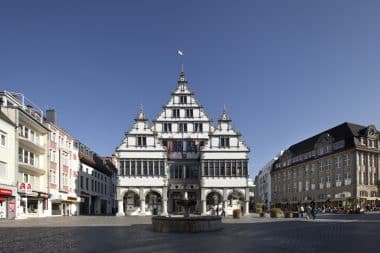
A stone’s throw from the cathedral, right in the heart of the city of Paderborn, the Pader rises in two large spring niches from over 200 springs. The surrounding Pader spring area provides a green city centre and is a candidate for the European Heritage Label.
The entire course of the Pader can be explored on a short, beautiful walk, as the body of water measures only 4.6 kilometres and is therefore considered the shortest river in Germany.
The source of the Pader is located in the city of Paderborn and is an association of over 200 springs that are fed from a huge underground water supply, the Paderborn karst spring system. These springs together form the Pader River. With up to 9,000 litres of water per second, the springs of the Pader are among the strongest inner-city springs in Europe. The abundance of water is one of the reasons why Charlemagne founded an imperial palace right here in 776.
Despite its short length, the river plays an important role in the local ecology and provides habitat for various animal and plant species.

Historic mills and water wheels along the river bear witness to the former use of water power.
The river offers numerous recreational opportunities for locals and tourists. Along the Pader there are beautiful parks and green spaces that invite you to walk, jog and relax. The clear, cool waters of the Pader are also a popular spot for anglers.
As an example of European water culture, the Pader is currently a candidate for the European Heritage Label. “What is particularly interesting about the Pader is how it is on the one hand quite typical for the historical water use of a European medium-sized city and on the other hand represents an isolated phenomenon due to the high concentration of economic, cultural and social facilities in a very small area directly on the river,” says Prof. Dr. Michael Ströhmer, expert in environmental and climate history with a focus on “Municipal Water Regimes” from the University of Paderborn.
Neuhaus Castle
Where the Pader flows into the Lippe stands one of Paderborn’s most famous landmarks: Neuhaus Castle. The magnificent building dates back to the 14th century. It received its present, striking design with moat and four-winged complex with round corner towers in the 16th century, making it one of the most important and beautiful examples of the Weser Renaissance.
Over the summer, cultural and art events take place in the extensive castle and floodplain park. One highlight is Germany’s largest street art fair “Performance Paderborn”. At the free fair, visitors can experience street theatre, artistry and creative street art. This year, on 4. and 5 September, around 50 artists will perform in 100 performances.
The largest computer museum in the world
Between the Paderquell area and Neuhaus Castle, technology enthusiasts will find the world’s largest computer museum. In the “Heinz Nixdorf MuseumsForum“, adults and children learn interactively about the invention of the computer, its further development to the present day and the future of information technology on around 7000 square meters of exhibition space. The forum is named after the Paderborn entrepreneur Heinz Nixdorf, pioneer of computer history and one of the most influential personalities of the German economic miracle.
When should you travel to Paderborn?
Basically, Paderborn makes a nice destination for a short break all year round. In winter, the large Christmas market runs through the city centre. In spring, the extremely green city centre and the surrounding area blossom and invite you to extensive bike tours. In summer and early autumn, numerous festivals and events take place, such as Libori (July), the graffiti festival “Secret City” (August) or the street art fair “Performance Paderborn” (September). So it depends entirely on your own preferences. But a visit to the still insider tip Paderborn is always worthwhile.

